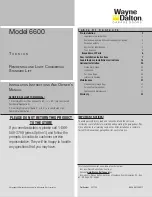
D600 AUTOMATED SYSTEM
RE-LOCK
RELEASE
Fig.2
User’s
guide
Read the instructions carefully before using the product and store them for future use.
GENERAL SAFETY REGULATIONS
If correctly installed and used, the D600 automated system will ensure a high degree of safety.
Some simple rules on behaviour can prevent accidental trouble:
- Do not, under any circumstances, stand under the door.
- Do not allow persons, animals or things to stay near the automated systems, especially while they are
operating.
- Transit must occur while the door is fully open and with the automated system stopped. Keep the door
under control during the entire movement and prevent other people accessing the area involved.
- Keep remote-controls, or other pulse generators that could open the door, well away from children.
-
IMPORTANT! DANGER OF CRUSHING.
- Once a month: check if the anti-crushing system is able to detect the presence of a 50 mm high
obstacle laid on the ground.
- Do not allow children to play with the automated system.
- Do not willingly obstruct door movement.
- Prevent any branches or shrubs from interfering with door movement.
- Keep the indicator-lights efficient and easy to see.
- Do not attempt to activate the door by hand unless you have released it.
- In the event of malfunctions, release the door to allow access and wait for qualified technical personnel to do the necessary work.
- When you have set manual operation mode, cut power to the system before restoring normal operation.
- Do not in any way modify the components of the automated system.
- Do not attempt any kind of repair or direct action whatever and contact qualified FAAC personnel only.
- At least every six months: arrange a check by qualified personnel of the automated system and the safety devices.
system fully re-opens the door. If the automated system operates in automatic logic, the door re-closes
after the pause time, otherwise, a new pulse has to be given to command closure. If an obstacle is
detected during the opening manoeuvre, this will stop motion (e.g. thus preventing things and people
from being lifted). To restore normal operation, give a new opening pulse.
If, during closure, an obstacle is detected in the same position more than three consecutive times, the
automated system considers this distance as the new closing contact point and goes into closed status.
To restore the correct positions, remove the obstacle and command a new cycle: at the next closure,
the automated system will advance at low speed until it detects the closing contact point.
The door is normally closed; when the control unit receives an opening command by radio control,
or from another type of pulse generator (Fig. 1), it activates the electric motor which, by means of a
transmission chain or belt, pulls the door open to allow access.
- If the automatic mode was set, the door closes automatically after pause time has elapsed. An
opening pulse given during the opening stage has no effect.
- If the semi-automatic mode was set, a second pulse must be sent to close the leaf again.
- An opening pulse supplied during opening, stops movement. An opening pulse given during re-closing,
always causes movement to be reversed.
- A stop pulse (if specified) always stops movement.
For details of door activity during the different logics, consult the installation engineer.
Accessories (photocells) may be present in automated systems, that prevent the door from closing when
there is an obstacle in the area they control.
Emergency manual opening is possible by using the release system.
The indicator-light (if supplied) indicates the current door movement.
The courtesy light is activated when the motor starts and continues for about 2 minutes after it turns off.
If the courtesy light flashes, this means that automated system is in shut-down status due to a fault, and
qualified personnel must be called in to repair.
MANUAL OPERATION
The D600 operator is equipped with an emergency release system activated from the inside – however,
a lock can be fitted on request, for activating the release from the outside too.
If the door has to be moved manually due to a power cut or fault of the automated system, use the
release device as follows:
- Turn off electric power to the system.
- Release the operator, by pulling the release handle downward (Fig. 2 ref. A).
Attention: make sure that there are no persons, animals or objects in the door movement area during
the release manoeuvre.
RESTORING AUTOMATIC OPERATION MODE
- Relock the automated system by pulling the handle horizontally (Fig. 2 ref. B) and make sure that, when
you release it, the “LOCK” window under the carriage is red, to confirm correct resetting.
- Move the door until you find the hook-on point.
- Power up the system.
MAINTENANCE
The D600 automated system does not require any periodic replacement of parts.
COURTESY LIGHT REPLACEMENT
To replace the lamp, grip the ceiling light with one hand and pull downward, as shown in Fig. 3.
Unscrew the lamp (type E27 - 230 Vac - max 40 W) and re-position the ceiling light.
DESCRIPTION
The D600 automated system is ideal to automate balanced sectional doors of single garages for residential use.
The automated systems consist of an electro-mechanical operator, electronic control unit and courtesy light built into a single unit.
The system is non-reversing and, therefore, the door locks mechanically when the motor is not operating and, consequently, no lock is necessary;
a manual release makes it possible to move the door in case of a power cut or fault.
The automated system has an electronic obstacle detection system. If an obstacle is detected during the closing manoeuvre, the automated
Fig.3
Fig.1
Содержание D600
Страница 1: ...D600 D600 ...
Страница 55: ...D600 D600 ...
Страница 56: ......
Страница 69: ......
Страница 121: ...note notes note notas anmerkung opmerkingen ...
Страница 122: ...note notes note notas anmerkung opmerkingen ...
Страница 123: ......
















































